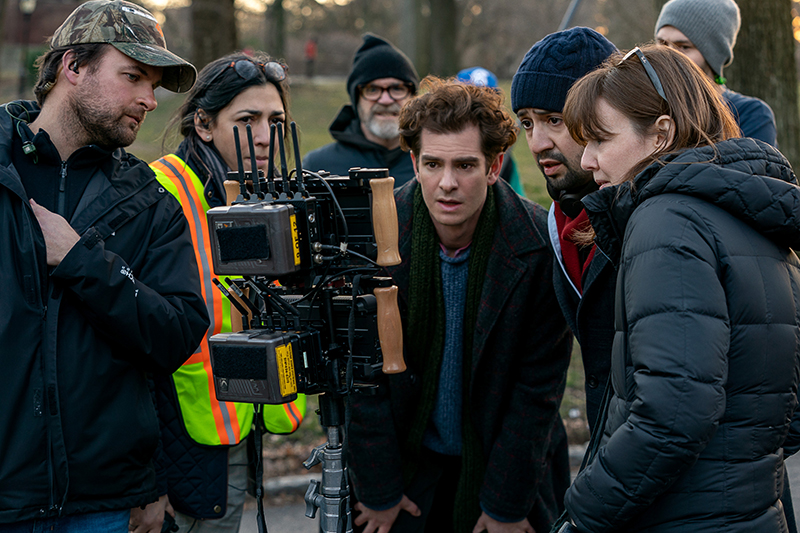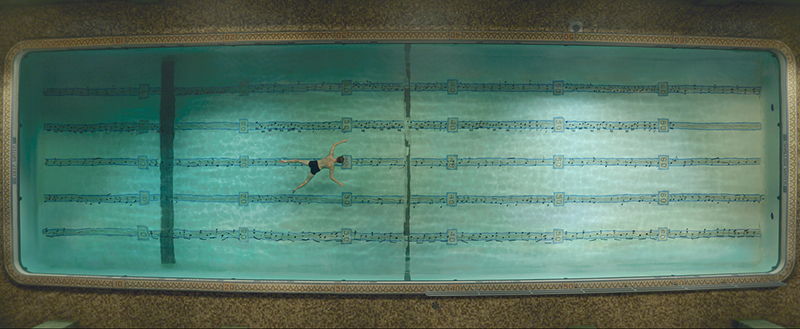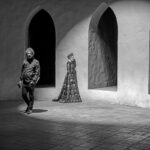
Alice Brooks captures the look of 1990s New York
If you have ever lived in a Manhattan apartment in one of the low-rent districts, you know the quality—or lack thereof—of the natural lighting there. The greenish-gray cast of the tallest building blocks the sun from entering your living room. Overcast days turn everything shadowy and just a little murky. Nights get their sparkle from passing cars, their headlights raking your walls and vanishing, taking the light with them. As the cinematographer for tick, tick…BOOM!, the Netflix movie adaptation of Jonathan Larson’s hit off-Broadway musical, Alice Brooks, ASC knew exactly what that kind of light looked like. She grew up in New York City in the 1980s and left the city for Los Angeles in 1990, the same year the movie takes place. Brooks, who was also the cinematographer for the summer 2021 movie adaptation of the Tony Award-winning musical In the Heights with director Jon M. Chu, has a special affinity for musicals. In fact, she and Chu are already in preproduction for the upcoming screen adaptation of another Tony winner, Wicked.
Quality of Light
Because of her New York City childhood as the daughter of a dancer and a playwright, mirroring the film’s main characters, Brooks felt an immediate, close personal connection to the story in tick, tick…BOOM! “As I turned page by page in the script, I said, ‘These could have been scenes from my childhood. I would watch my father struggle to try to make it,” explains Brooks. “We had a tenement apartment with a bathtub in the kitchen. “Boho Days” could have been a Saturday night at our apartment!” When Brooks pulled out photos from her childhood home and showed them to director Lin-Manuel Miranda, “he first thought they were just for reference,” she says. “Then he said, ‘Wait, these are your personal photos!’ Lin and I wanted the New York City of 1990 to feel and look like each of us remembered it back then—from the perspective of a 10-year-old—where color and light and emotions are all heightened. Jonathan Larson is childlike in many ways. We created our visual language from this childlike perspective where the lines between dreams and reality are sometimes blurred. This became the jumping-off point for us—to stay real and true to Jonathan’s real life—but also to capture a dreamlike quality.”
Jonathan, the play’s semi-autobiographical main character, faces his 30th birthday as he prepares for a workshop of his first musical. Still living in his dingy Bohemian-style apartment while his friend and former roommate Michael moves up to an airy uptown penthouse, he waits for someone—specifically Stephen Sondheim—to discover his songwriting talent. The cramped, two-room, railroad-style apartment was built on a soundstage to be an almost exact replication of Larson’s apartment. “We had video record of every aspect of the apartment because Larson was scared it was going to burn down, so he recorded everything for insurance purposes,” comments Brooks. “I kept watching the video to understand what the light was doing in the space. It was important to me that it felt like everything was either lit by practicals or light coming in the windows.”

Choosing the Right Equipment
The practicals, according to Gaffer William O’Leary, were for the night look—during the party scene early in the movie, and again as Jon struggles overnight to write a key song before the workshop. “We used Steel Green, Lee gel, #728, just on a tungsten fixture,” he says. “A lot of times we tried to mix colors outside, certainly at night, with a more straightforward look for the day work. We used 10kWs on a rail, and we put a little CTO [Color Temperature Orange] with them, and we brought in some soft ambiance as well for the day work. We had a lot of different looks in there—sunny day, overcast day, night when they shut the power off, the party scene.”
O’Leary made use of a lighting package loaded with Mole Richardson units from 10kWs to tweenies and inkies, and lots of Kino Flo tube fixtures, as well as an array of more specialized instruments. For the effect of passing cars, he used about 80’ of Chroma-Q Color Force 72 LED Battens, programmed by Board Operator Jim Galvin to chase as needed. “We could go left to right or right to left, and we kept that a little neutral, like headlights,” O’Leary explains. “The apartment was on the third floor, so we brought that light up from below.” The apartment interior turned out to be the thing O’Leary was most proud of in the film, he noted. “It didn’t look lit.”
Brooks wanted to keep the lighting instruments out of the set itself, to give Andrew Garfield, playing Jonathan, as much space as possible to work within the confines of the small rooms. This also provided more space for the two Panavision DXL2 cameras, equipped with Panavision G series anamorphic lenses. “There were a couple of days when we had three cameras, but for the most part we were in very small locations and didn’t have a lot of room,” she says.

Colorful Inspiration
One of the three-camera days came when filming the brilliant ode to Sondheim’s Sunday in the Park with George, at the diner where Jonathan holds down a survival job waiting tables. In an imagined attempt to bring order to the chaos of Sunday brunch, a wall of the diner drops down to become a stage as Jonathan conducts the demanding customers into balance, flooding the diner with light and dissolving the city street into a Seurat-like pointillist painting. “Sunday was a complete joy to make,” comments Brooks. “We were inspired by Sunday in the Park, and watched the PBS recording over and over. I was also inspired by the painting—A Sunday on La Grande Jatte, by Georges Seurat.”
To emphasize the richness of the scene’s bright colors, “We overexposed everything,” Brooks says. “We made everything a little brighter once the wall comes down. It’s the brightest lit scene in the movie; it’s magical. The brightness and overexposure help when the scene is transformed into the pointillist painting.” At the same time, the lighting stays naturalistic, allowing the fantasy to come from the opening of the wall and the customers breaking into song. Working outside the set with incandescents, O’Leary placed three 10kWs on rails, allowing them to slide back and forth. “We had two 20kWs on a scissor lift right over the diner in a corner of the stage, and we put a big soft directional source in it,” he said. “We had 120 space lights above for ambiance, and they also lit the greenscreen.” Astera LED Tubes put some shine across the stainless steel on the back wall of the diner, and a polystyrene bounce board aimed extra light on actors’ faces.
Later, a night scene at the diner required a different look. “We reduced the intensity of the space lights, we cooled them off, and we put in a tiny bit of blue [Arri] SkyPanels to light the greenscreen,” O’Leary explains. A streetlight pole allowed O’Leary to hang baby 1kWs outside, providing the appropriate ambiance for a visit from Jonathan’s girlfriend, Susan, and a private conversation between them on the street. “We kept it kind of simple for the most part,” says O’Leary.
Years in the Making
Based on his theater background, Miranda brought a collaboration process to making the film and didn’t feel a need to solve every issue on his own. “We prepped for 14 weeks before we started shooting,” says Brooks. “Lin isn’t someone who feels he needs to know all the answers right away. With a play, you workshop for years before you have a public performance. So, Lin, the production designer, the writer, the assistant director, and I also worked closely together. The writer was there so if we had script ideas that Lin wanted to incorporate, he could add them in.” The team storyboarded much of the film. “I would cut animatics out of the storyboards to the prerecorded music,” Brooks said.
This process opened up the opportunity for “discovery moments,” like the one in the song “Swimming.” The production team went together to look at the pool. The pool floor had tiled numbers marking distance intervals. “There was a 30 in the middle of the pool, and Lin said, ‘What if he touches the 30, the age he is so scared of turning, and it turns into a treble clef?’” This concept evolved to the magical moment when Jonathan sees the lines on the pool floor become music staffs, and the melody of the song he has struggled to write appears as notes on the staffs. “Then we needed a big overhead shot, so that the musical score can be seen in its entirety,” comments Brooks.
To light this sequence so that Garfield is brightly visible from underwater as he swims laps, O’Leary says that he started by turning off the existing house lights in the pool house. “They were a hideous metal halide wash,” he explains. “Then for the wall-mounted fixtures, we put Astera Tubes in those that we could control with Bluetooth.” To maintain safety for the actors and crew, since the lights were kept off in the poolroom itself, the lighting team used the two horizontal rows of windows on one side of the pool for additional lighting opportunities. “We put a scaffolding outside with a 2.5kW HMI outside of each window, and that would be the keylight—enough lights are put together in a line that they become a soft light.”
The lower set of stippled-glass windows would be in the shots. “We took tweenies and put 1½ CTO on those with a sodium look, so it looked like a streetlight,” says O’Leary. “We warmed those way up so they would have that orange, sodium look.” The overall effect is magical realism that anyone who has had a moment of crystallized insight and inspiration can relate to.
“I am most proud of helping Andrew and Lin capture Jonathan’s spirit without having the camera get in the way,” Brooks says. “We have this very intimate, personal story that honors Jonathan, but also honors all artists who pursue their dreams. Sometimes realizing those dreams is hard, and you have mornings when you don’t want to get out of bed, that you don’t want to push through anymore. This movie is for people who know they have something to offer the world and just have to keep pushing through despite the difficulty.”
Randi Minetor is an author and freelance writer based in upstate New York.


